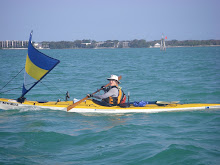
I've been a Pacific Action Sail (PAS) kayaker for over five years, but this year I'm making a change from the PAS to the Flat Earth Sail (FES). Both sails are 1 sqm, which is the maximum for Class 1 of
WaterTribe's Everglades Challenge (EC).
I had three sails to choose from, which I believe are up to the rigours of an EC: the New Zealand designed and made
PAS (as above), the Australian designed and made
FES, and the American Balogh Sail Design's (
BSD) 1 sqm. I have all three sitting here at home with me, and all three have varying capabilities.
The BSD is probably the best "sail" unit there is, but for me--a solo kayaker--I came to the hard conclusion that BSD's rig is a bit too complicated, high and heavy for my needs. And to stow it, I would need to get out of my boat and dismantle and tuck everything away in an already small, pod-seated cockpit. If I had a
Kruger canoe, this would be a different conversation. BSD's Dave was also keen for me to fit the rig behind me, but then I wouldn't be able to trim or watch my luff as easily.
I have really enjoyed the PAS--my first EC I hit a consistent 25 kph (15.5 mph) in high winds and following seas! With my sailing experience, I believe I've been able to get more out of it than most, particularly closer up to windward. And being able to easily deploy the sail from the cockpit has been very useful. The sail is nylon, and I've found it's distorted over time; and PAS is not going to transfer to more typical sail material anytime soon.

I haven't yet had a chance to test my new Code Zero-styled FES (that's Dawn (
SandyBottom) using hers above), but all the
video and
reviews I've watched and read with the sail in use has me excited about the possibilities. The sail shape and rigging concept is very Tasmanian--the folks who have really pushed sea/sailing kayaking to its limits. Like the PAS, the unit can be deployed from the cockpit. And FES users attest to being able to point up to windward quite a bit higher. Technically, it's 122cm (48") high, the boom is 87.63cm (34.5”), and the top batten (of two) is 119cm (47")--the lower batten acts as the boom. Sail material for the Code Zero is a white trilaminate sail material, which means it only comes in white.

Just like the PAS, the FES depresses the thin fibreglass of my for'deck. For the PAS, I had a unit made that the PAS rested on (see top photo). For the FES, I am extremely grateful that
Alan (SOS) and
Paul (DancesWithSandyBottom) Stewart have spirited my boat away to
Graeme Byrnes' (Roo) boatyard--where Alan works--and are strengthening the underdeck with epoxy. I don't envy them this weekend--temperatures were down to -6C (20F) last night, with only around 4C (40F) today, albeit sunny. In the photo above, you can see the SpongeBob Pants-looking heater atop the for'ad hatch, trying to dry the epoxy!
 They say that half's the battle's getting to the beach to compete in the Everglades Challenge. I've usually found that half the fun is packing. But it's been a wee bit more stressful than usual in the last week or so--our son has been diagnosed with a rare kidney disease--Poststreptococcal glomerulonephritis (PSGN)--which has no treatment. But he now seems to be on the mend. So we still hope to be leaving for Florida on Thursday, ready for race start on Saturday, March 3....
They say that half's the battle's getting to the beach to compete in the Everglades Challenge. I've usually found that half the fun is packing. But it's been a wee bit more stressful than usual in the last week or so--our son has been diagnosed with a rare kidney disease--Poststreptococcal glomerulonephritis (PSGN)--which has no treatment. But he now seems to be on the mend. So we still hope to be leaving for Florida on Thursday, ready for race start on Saturday, March 3.... The new Flat Earth 1sqm sail is all up and ready, but I won't have a chance to test it out before the race starts. That would be too easy.
The new Flat Earth 1sqm sail is all up and ready, but I won't have a chance to test it out before the race starts. That would be too easy.










